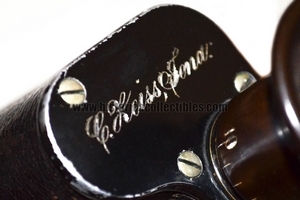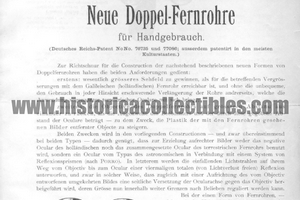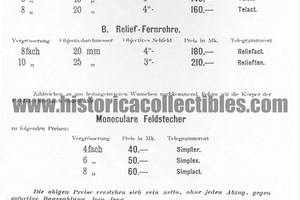Feldstecher 4x11 C. Zeiss Jena Nr. 7 - Ebonite Eyepieces, Oldest Zeiss Binoculars Known, 1894
This is the oldest binoculars known to date, produced by Carl Zeiss Jena in the first year of production 1894, in only 9 specimens.
This 4x binoculars and objective lenses of 11 mm, made in 1894, the year which marks the first production of prismatics binoculars Zeiss, reports the serial number "7", which is the seventh binoculars ever produced by Carl Zeiss of the 9 specimens. Besides the serial number, as critical to the exact date, the characteristics that lead back to the very first production are: 11 mm objective lens; 4 screws on the bridges (later models will be equipped with 5 screws); oculars Ebonite with numbers hand engraved (completely intact); top plates made of aluminum and those underneath of brass; on the left plate mark with abbreviation "C.Zeiss,Jena." and on the right plate D.R.P. "Deutsches Reichspatent" (Patent of the German Empire).
The earliest productions were subject to sudden changes in technical and aesthetic, designed to improve its features, here is why in the face of these reasons, it is estimated that these binoculars were produced in small batches, which were limited to a very small number of specimens. 1894 was indeed a year in which the Zeiss effected continuous variations making even the smallest changes between specimens. Already the following year "1895", the Zeiss was commissioned for a production of binoculars designed for military use.
It is in exceptional state of preservation. Excellent vision that appears to be clear, clean and collimated.
A very versatile and pocket binoculars and indeed its modest weight is about 300 grams.
Complete with its original neck strap.
Carl Zeiss takes its name from its founder, Carl Zeiss, who on November 17, 1846 chose the small town of Jena, in Thuringia, as the location for his precision optical equipment factory. Thanks to the severe quality control that Carl Zeiss imposed on his products, going so far as to personally destroy the microscopes that did not pass the tests, the newly formed Zeiss became the official supplier of the University of Jena and received the gold medal of the industrial exhibition in 1861 of Thuringia as the best research instrument produced in Germany, awarded to the Stand I microscope of 1857.
In 1866 the thousandth microscope was produced and the name Zeiss became known throughout European scientific circles. Thanks to studies on the Porro prism, in 1893 Abbe patented double prism binoculars, which accentuated the perception of depth. The mass production of Zeiss binoculars began in 1894, already at the beginning of the twentieth century more than 30,000 were made, at the beginning of the First World War the quota had risen to 500,000 and, at the end of the Second World War, as many as 2,260,000 were produced binoculars for the civil and military market.
Thanks to studies conducted on the perception of light in low light situations, it was demonstrated that the average dilation of the pupil in an adult is approximately 7 mm. For this reason, the 7x50 mm model was introduced in 1910 and remained on the market until 1917 with few changes to the materials used. In 1926, following the post-war crisis of the First World War with the Treaty of Versailles which bankrupted many important German companies, Zeiss purchased "C.P. GOERZ" and founded Zeiss Ikon in 1926.
In 1937 Zeiss had commercial contacts and factories in more than 29 countries around the world. From '33 Zeiss acquired interest from the Nazi regime, which balanced production towards military instruments. It successfully produced binoculars with wide-angle optics for military use, pressure-resistant optical systems for U-boats, periscope binoculars for targeting tanks. Furthermore, Zeiss cameras were mounted on the V2s for remote sensing operations of the English coasts.
On 1 November 1935, Zeiss, in the figure of Alexander Smakula, patented a process for the treatment of optical glass with extraordinary results in terms of light transmission. Remained a military secret until 1939, it was adopted on binoculars to reduce ghost images and internal reflections. During the Second World War, there were numerous bombings against the Zeiss factories. Jena was bombed several times by the Allies starting in 1944. Stuttgart was razed to the ground, although the Contessa-Nettel factory suffered little damage. The bombing of Dresden, in addition to devastating the city, also caused considerable damage to the Zeiss Ikon headquarters.
On April 13, 1945, American military forces entered Jena, surprising themselves that the bombing had not caused any significant damage. The main planetarium was in ruins, while the factories remained operational.







